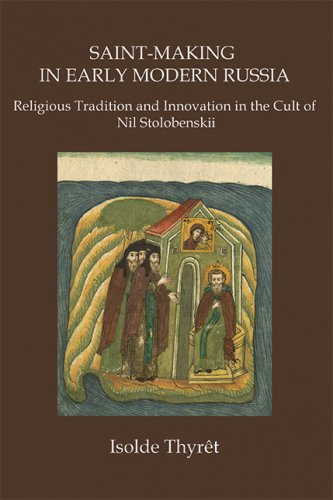
About the Author
Isolde Thyrêt, Associate Professor of History at Kent State University, specializes in the study of medieval and early modern Russian religious culture. She has published numerous articles in several languages on the cults of Russian Orthodox saints, women and religion, monasticism, the phenomenon of dual faith in early Russia, and Russian visual culture during the Muscovite period. Her previous book Religious Symbolism and the Royal Women of Muscovite Russia (2001) received both a regional and a national award.
SAINT-MAKING IN EARLY MODERN RUSSIA: Religious Tradition and Innovation in the Cult of Nil Stolobenskii
Isolde ThyrêtNew Academia Publishing, 2019
754 Pages, 76 Illustrations
ISBN 978-1-7330408-0-8 Paperback
ISBN 978-1-7333980-3-9 Hardcover
$76.00 Hardcover
For BULK ORDERS, order directly from New Academia Publishing.
Queries: orders@newacademia.com
About the Author
Isolde Thyrêt, Associate Professor of History at Kent State University, specializes in the study of medieval and early modern Russian religious culture. She has published numerous articles in several languages on the cults of Russian Orthodox saints, women and religion, monasticism, the phenomenon of dual faith in early Russia, and Russian visual culture during the Muscovite period. Her previous book Religious Symbolism and the Royal Women of Muscovite Russia (2001) received both a regional and a national award.
About the book
Based on a case study of the formation of the cult of the Russian saint Nil Stolobenskii in the seventeenth century, this book provides insight into the complex dynamics of the saint-making process in early modern Russia. Utilizing a large array of documentary, literary, and visual sources, the author investigates the importance of a growing patronage network for the cults of early Russian saints and the role that local laymen and monks and high-ranking Russian Orthodox church officials played in the development of the hagiographic, liturgical, and iconographic image of individual saints and in the creation of the physical infrastructure of their cults. Saint-Making in Early Modern Russia challenges the prevailing view that the Russian Orthodox Church hierarchy determined the success of a saint’s cult in the Muscovite period by demonstrating the crucial contribution of the leaders of the Nilov Hermitage to the development of Nil Stolobenskii’s cult in the seventeenth century. By placing the achievements of these monastic figures within the wider theological, spiritual, and artistic framework of Eastern Orthodoxy that they operated in, this study affords the reader a rare view into the creativity of native Russian religious culture before the influx of Western ideas started to reshape the Russian Orthodox spiritual experience in the later seventeenth century. In light of its interdisciplinary and comparative approach to the topic, this book will appeal to historians, art historians, and experts in religious studies who are interested in the cult of saints in both Russia and the West.
Praise
“Thyret’s account is quite innovative. She has provided a concrete example of exactly how the veneration and recognition of the saint evolved, including at various times the monks of Nil’s monastery, the church authorities, the surrounding society near the monastery, and the court elite in Moscow. In doing so she makes an important contribution to the ongoing discussion about the making of saints in early modern Russia.” — Paul Bushkovitch, Professor of History, Yale University.
“This is a remarkable case study of the creation and evolution of a saint’s cult in 17th-century Rus’. In documenting the growth and development of the Stolbnoe monastery and the veneration of its holy man the author draws upon a multi-faceted array of sources and methodologies, incorporating elements from literary and hagiographical approaches, historical studies, art history, and examination of the physical environment. This Russian phenomenon is also placed within the larger context of the growth of saints’ cults as they became established in medieval Western Europe, with focus on how the Russian example both fits a general pattern and displays areas of divergence.” —Ann Kleimola, Professor of History (retired), University of Nebraska.





 Coming Soon
Coming Soon Awards
Awards